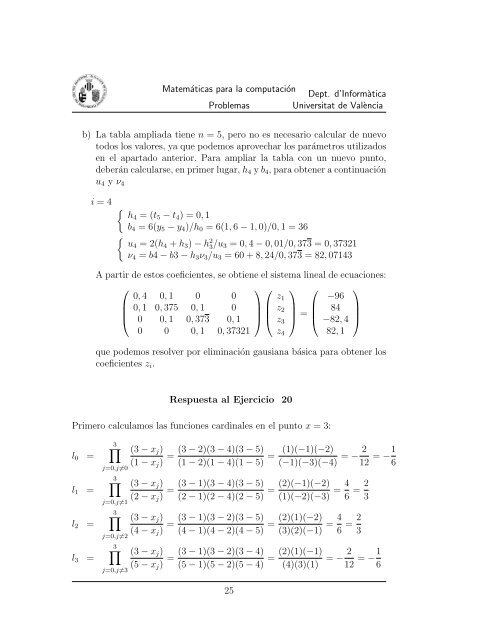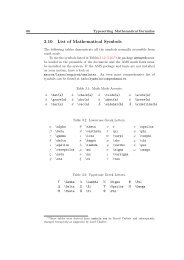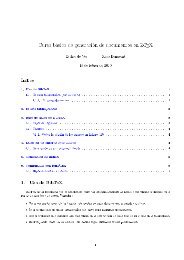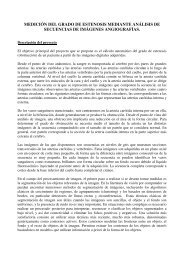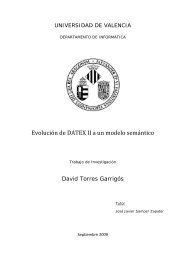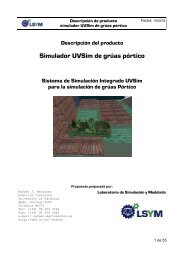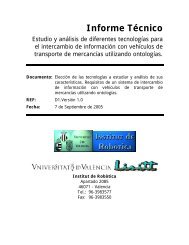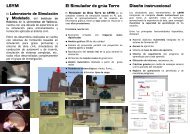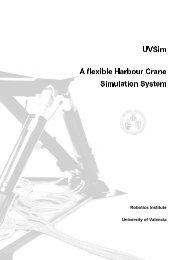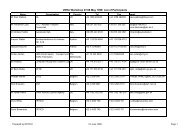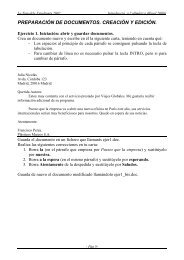Matemáticas para la Computación
Matemáticas para la Computación
Matemáticas para la Computación
Create successful ePaper yourself
Turn your PDF publications into a flip-book with our unique Google optimized e-Paper software.
<strong>Matemáticas</strong> <strong>para</strong> <strong>la</strong> computaciónDept. d’InformàticaProblemas Universitat de Valènciab) La tab<strong>la</strong> ampliada tiene n = 5, pero no es necesario calcu<strong>la</strong>r de nuevotodos los valores, ya que podemos aprovechar los parámetros utilizadosen el apartado anterior. Para ampliar <strong>la</strong> tab<strong>la</strong> con un nuevo punto,deberán calcu<strong>la</strong>rse, en primer lugar, h 4 y b 4 , <strong>para</strong> obtener a continuaciónu 4 y ν 4i = 4 {h4 = (t 5 − t 4 ) = 0, 1b 4 = 6(y 5 − y 4 )/h 0 = 6(1, 6 − 1, 0)/0, 1 = 36{u4 = 2(h 4 + h 3 ) − h 2 3/u 3 = 0, 4 − 0, 01/0, 373 = 0, 37321ν 4 = b4 − b3 − h 3 ν 3 /u 3 = 60 + 8, 24/0, 373 = 82, 07143A partir de estos coeficientes, se obtiene el sistema lineal de ecuaciones:⎛⎞ ⎛ ⎞ ⎛ ⎞0, 4 0, 1 0 0 z 1 −96⎜ 0, 1 0, 375 0, 1 0⎟ ⎜ z 2⎟⎝ 0 0, 1 0, 373 0, 1 ⎠ ⎝ z 3⎠ = ⎜ 84⎟⎝ −82, 4 ⎠0 0 0, 1 0, 37321 z 4 82, 1que podemos resolver por eliminación gausiana básica <strong>para</strong> obtener loscoeficientes z i .Respuesta al Ejercicio 20Primero calcu<strong>la</strong>mos <strong>la</strong>s funciones cardinales en el punto x = 3:l 0 =l 1 =l 2 =l 3 =3∏j=0,j≠03∏j=0,j≠13∏j=0,j≠23∏j=0,j≠3(3 − x j )(1 − x j )(3 − x j )(2 − x j )(3 − x j )(4 − x j )(3 − x j )(5 − x j )=(3 − 2)(3 − 4)(3 − 5)(1 − 2)(1 − 4)(1 − 5) = (1)(−1)(−2)(−1)(−3)(−4) = − 2 12 = −1 6=(3 − 1)(3 − 4)(3 − 5)(2 − 1)(2 − 4)(2 − 5) = (2)(−1)(−2)(1)(−2)(−3) = 4 6 = 2 3=(3 − 1)(3 − 2)(3 − 5)(4 − 1)(4 − 2)(4 − 5) = (2)(1)(−2)(3)(2)(−1) = 4 6 = 2 3(3 − 1)(3 − 2)(3 − 4)=(5 − 1)(5 − 2)(5 − 4) = (2)(1)(−1)(4)(3)(1)= − 2 12 = −1 625


